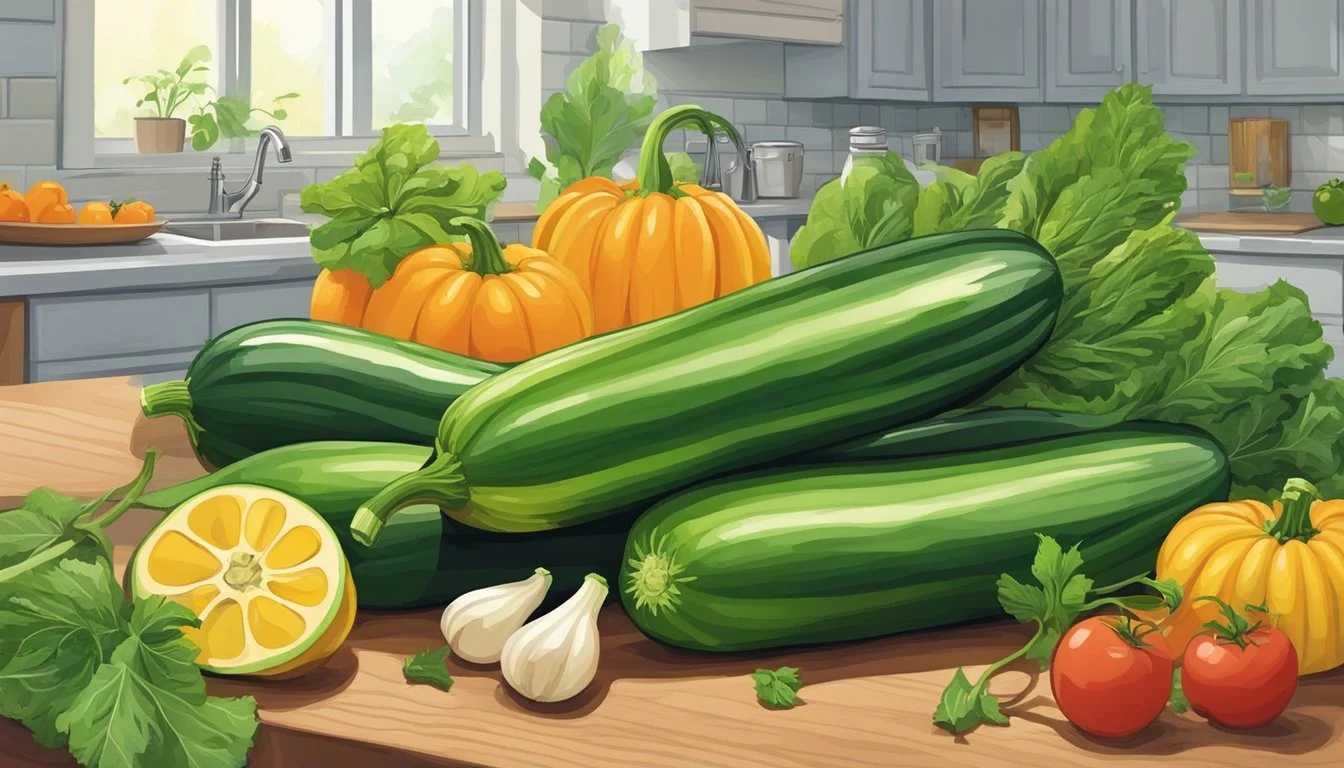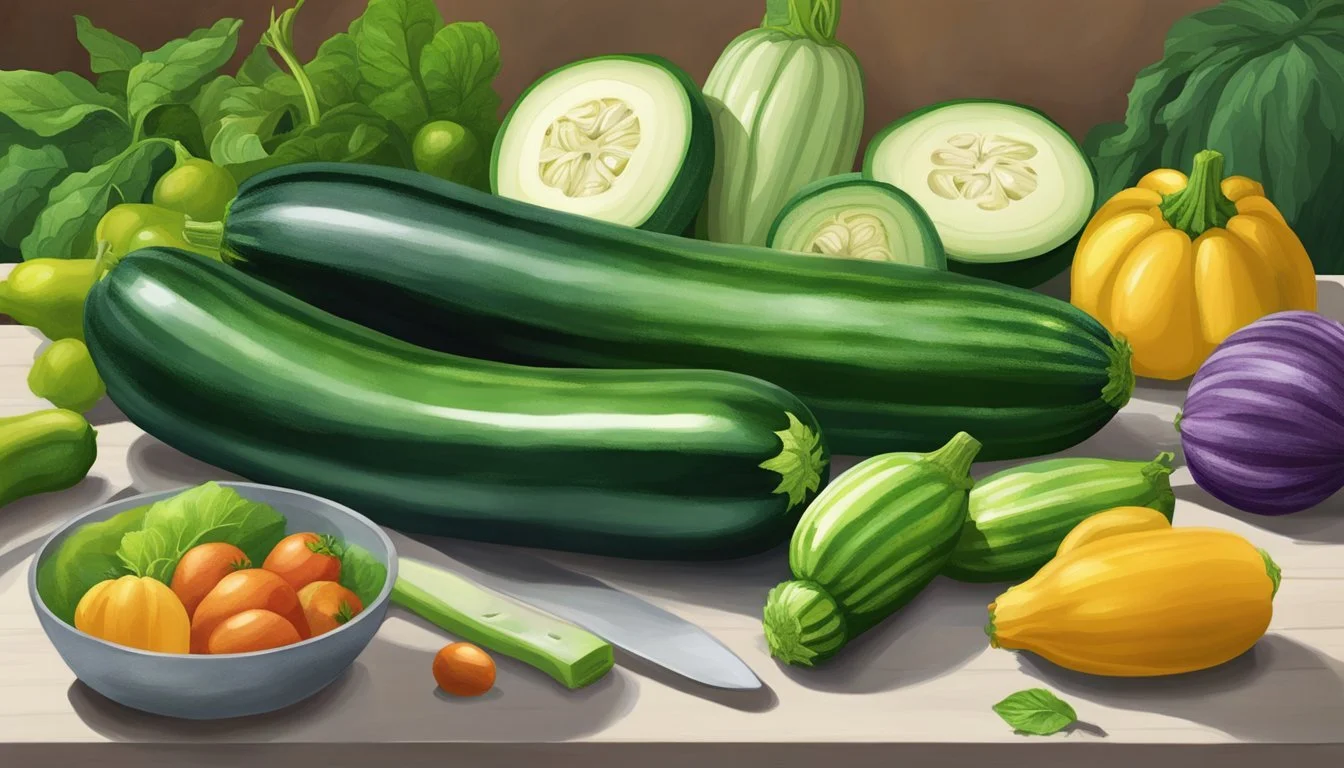How Long Does Zucchini Last?
Shelf Life and Storage Tips
Zucchini (What wine goes well with zucchini?), a versatile summer squash, is a popular ingredient enjoyed in a variety of dishes from stews to breads. Its shelf life, however, is influenced by several storage conditions. When stored at room temperature, zucchini typically lasts about 3 to 4 days before it begins to deteriorate, making it important for individuals to plan their usage shortly after purchase.
Storing zucchini in a refrigerator extends its freshness considerably. When kept in the crisper drawer, zucchini can stay fresh for approximately 1 to 2 weeks. The key to longer shelf life in the fridge is to limit extra moisture, which can accelerate spoilage. This involves not washing the vegetable until right before use and potentially wrapping it in paper to absorb any excess moisture.
For those who wish to keep zucchini for an extended period, freezing presents a viable option. Properly prepared and stored, zucchini can last in the freezer for up to 3 months. Blanching zucchini before freezing helps to maintain its texture and color, ensuring that it remains a quality ingredient for future recipes.
Understanding Zucchini
Zucchini is a highly versatile summer squash that offers both a delicate flavor and a substantial nutritional profile. This section will explore its characteristics, nutritional value, and culinary applications.
Characteristics of Zucchini
Zucchini, originating in the Americas, is green in appearance, though it can also be found in yellow and light green varieties. It typically grows to 15 to 25 centimeters in length, although it can grow larger. When selecting zucchini, one should look for firm, glossy skin and avoid those with cuts or bruises.
Nutritional Profile
Zucchini is known for its low calorie count and being rich in vitamins and minerals. Here is an overview of its nutritional makeup (per 100 grams):
Calories: 17
Water: 95%
Protein: 1.21 g
Carbohydrates: 3.11 g
Dietary Fiber: 1 g
Sugar: 2.5 g
Vitamins: Vitamin A, C, and K, along with several B vitamins
Minerals: Potassium, manganese, magnesium, and small amounts of iron and calcium
Zucchini is especially noted for its vitamin C content, which acts as an antioxidant and contributes to immune function.
Culinary Uses
Zucchini is known for its versatility in the kitchen. Its mild flavor makes it a favourable addition to a wide range of dishes, from savory to sweet. It can be grilled, steamed, sautéed, spiralized into 'zoodles', or even incorporated into baked goods like zucchini bread. The vegetable's ability to absorb flavors and contribute moisture to dishes makes it a favored ingredient among cooks.
Storing Zucchini
Proper storage methods can significantly extend the shelf life of zucchini whether it's stored in the short term or prepped for longer periods.
Short-Term Storage
For fresh zucchini, keeping it in the refrigerator is the best option to maintain its freshness for up to two weeks. The refrigerator should be set to maintain a consistent temperature, which helps preserve the zucchini. It's important to store the zucchini in the crisper drawer to benefit from the lower humidity, which is conducive to keeping vegetables fresh. Zucchini should be placed in a plastic bag, one that is perforated, or wrapped loosely with a paper bag to allow some air circulation. Do not wash zucchini before refrigerating; moisture can speed up the decaying process.
Long-Term Storage
When one intends to store zucchini for months, freezing is the preferred method. Before freezing, wash and cut the zucchini into the desired size, such as 1/2-inch thick rounds. It's then blanched in boiling water for 1 to 2 minutes, followed by an immediate transfer to an ice bath to halt the cooking process. After draining and patting dry, the pieces can be packed into airtight containers or freezer bags. The removal of as much air as possible prevents freezer burn. In the freezer, zucchini can last up to three months.
Alternative Storage Methods
At room temperature, whole zucchini can be kept in a cool pantry for about 3 to 4 days. Sliced or cut zucchini should be eaten within this time frame when stored in an airtight container in the refrigerator to prevent moisture buildup. For whole zucchini that's not needed for immediate use but doesn’t require freezing, one can store them in the refrigerator crisper drawer for up to three weeks. When dealing with cut zucchini, it's beneficial to line the container with paper towels and change them regularly to absorb excess moisture.
When it comes to getting the best deals, buying paper towels online is the way to go!
Freezing Zucchini
Freezing zucchini is an excellent way to preserve this versatile vegetable for future use. When properly prepared, blanched, and stored, frozen zucchini can maintain quality for several months.
Preparing Zucchini for Freezing
Firstly, one must wash the zucchini thoroughly to remove any dirt. Then, depending on the intended use, zucchini should be cut into even slices, shredded for baked goods, or spiralized to create zoodles. Uniformity in size helps ensure consistent freezing and thawing.
Blanching Zucchini
Blanching is a critical step for preserving the texture and color of zucchini before freezing. Place the prepared zucchini in boiling water for 1-2 minutes for slices and about 2 minutes for shredded or spiralized forms. Immediately after blanching, transfer the zucchini to a bowl of ice water to halt the cooking process.
Storing Frozen Zucchini
Once the zucchini has cooled and drained, lay it out on a baking sheet with parchment paper in a single layer to prevent clumping. Freeze for 1-2 hours until solid. Subsequently, transfer the frozen zucchini to a zip-top bag or an airtight container, label with the date, and return it to the freezer. When ready to use, zucchini can be defrosted in the refrigerator or cooked directly from frozen.
Strongly suggest acquiring labels through the internet for a hassle-free shopping journey!
Preventing Spoilage
Proper storage and vigilant observation are pivotal in preventing spoilage of zucchini. Understanding the indications of deterioration and maintaining optimal storage conditions are key strategies to keep zucchini fresh for an extended duration.
Identifying Signs of Spoilage
One should routinely inspect zucchini for certain signs that suggest spoilage. A spoiled zucchini often exhibits:
Visual Inspection: Look for visible mold, usually white or greenish in color, and check for any signs of rot or decay.
Texture Changes: A bad zucchini may have a slimy or soft texture. Fresh zucchini is firm to the touch.
Odor: A sour or unpleasant odor is a clear indicator that the zucchini has gone bad.
Surface Changes: If the green skin shows multiple spots, wrinkles, or shriveling, it could indicate that the zucchini is no longer fresh.
Optimal Conditions to Prevent Spoilage
To prolong the shelf life of zucchini and prevent spoilage, one should:
Temperature: Keep zucchini in the refrigerator, ideally within the crisper drawer to retain humidity levels and maintain firmness.
Humidity: Zucchini requires a certain level of humidity but should not be kept in overly wet conditions. A sealed plastic bag can help manage moisture levels.
Visibility: Store zucchini where it can be easily seen and checked regularly for any signs of spoilage, encouraging prompt usage before it goes bad.
Utilization of Zucchini
Zucchini is a versatile ingredient that can be prepared in numerous ways, whether used fresh, frozen, or as the star of a dish. Each preparation method brings out a different texture and flavor profile, suitable for a variety of recipes.
Cooking With Fresh Zucchini
Fresh zucchini is perfect for immediate use and offers the best texture and flavor. It can be sautéed, roasted, grilled, or steamed, with each cooking method enhancing its natural taste. For a quick and nutritious addition to any meal, slicing zucchini and incorporating it into salads or pasta dishes is common. The firm yet tender flesh of fresh zucchini makes it ideal for creating structured dishes like casseroles.
Sauté: For a quick dish, thinly slice the zucchini and cook in a hot pan with a bit of oil until tender-crisp.
Roast: To enhance its flavor, chop zucchini into bite-sized pieces, drizzle with olive oil, and roast until golden brown.
Grill: Cut zucchini lengthwise, brush with oil and seasoning, and grill to achieve smoky char marks.
Steam: For a lighter approach, steam chopped zucchini until just softened, preserving its nutrients and subtle taste.
Recipes for Frozen Zucchini
Frozen zucchini is ideal for long-term storage and can be used in a variety of cooked dishes. While its texture may change, making it softer than fresh zucchini, it is still suitable for soups, stews, and baked goods like zucchini bread. When freezing, it's best to blanch zucchini first to preserve its color, flavor, and nutrients.
Soups/Stews: Thawed zucchini can be added to soups and stews for extra nutrition and texture.
Zucchini Bread: Grated frozen zucchini, once thawed and drained, is an excellent moisture provider in zucchini bread recipes.
Creating Zucchini-Based Dishes
Zucchini serves as a base for an array of dishes where its flavor can be seasoned and shaped to suit the recipe. It can be grated or shredded for fritters, spiralized to make zoodles as a low-carb pasta alternative, or blended into zucchini soup for a light and flavorful meal. Leftover zucchini is particularly useful in such dishes, ensuring no waste and a new culinary creation.
Shred/Grate: Use shredded or grated zucchini in fritters, pancakes, or as a texture enhancer in meatloaf.
Spiralize: Spiralized zucchini makes for a healthy pasta substitute that's quick to cook and can be paired with various sauces.
Blending: Pureed zucchini adds creaminess to soups or sauces, enriching the dish without overpowering it.
Zucchini Lifecycle
The lifecycle of zucchini from harvest to consumption involves careful handling to maintain freshness and quality. Understanding the stages post-harvest helps in reducing waste and optimizing shelf-life.
From Harvest to Table
Zucchini is best harvested when it reaches a size between small to medium—approximately 6 to 8 inches in length—which typically ensures a firm texture and vibrant green color. At markets, one often sees fresh zucchini displayed, indicating they are ready for immediate consumption. The typical shelf-life for unwashed and uncut fresh zucchini in a refrigerator is up to two weeks, given that excess moisture is controlled. It is crucial to keep them separate from produce with high water content to minimize spoilage.
Zucchini After Purchase
Once purchased, zucchini begins to experience changes in texture and flavor, influenced by its storage environment. To extend its shelf-life and maintain firmness, one should:
Store the zucchini in the refrigerator's crisper drawer.
Keep it uncut and unwashed until ready for use to minimize exposure to moisture.
If fresh zucchini won't be used promptly, freezing is an option, prolonging its viability for several months. Freezing requires blanching zucchini first to preserve quality.
Lifecycle of a Zucchini in the Kitchen
In a domestic kitchen setting, the zucchini goes through final consumption stages. Cut or sliced zucchini should be kept in an airtight container and will last for 3 to 4 days in the refrigerator. Cooked zucchini similarly retains quality for about the same duration when stored properly in the refrigerator. Any prepared zucchini showing signs of spoilage should be discarded to avoid waste and potential health risks.





